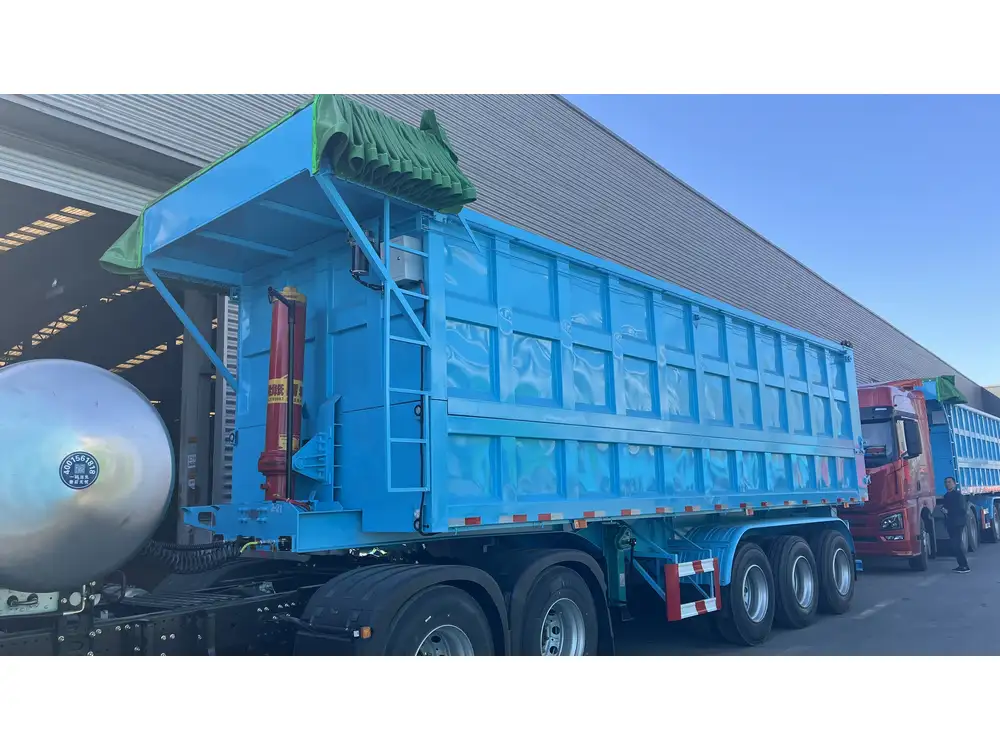When navigating the world of semitrailers, one critical aspect that demands attention is the oil capacity—the amount of oil these massive vehicles can hold, which significantly affects their performance, maintenance, and efficiency. Here, we will delve into various factors influencing oil capacity, the significance of proper oil management, and troubleshooting common issues that arise with incorrect oil levels.
The Basics of Semi-Trailer Oil Capacities
What is Oil Capacity?
Oil capacity refers to the maximum amount of oil that an engine, transmission, or other components in a semi-trailer can hold. Generally measured in gallons, this parameter is crucial for ensuring that the vehicle operates optimally, preventing potential failures caused by inadequate lubrication.

Why Oil Capacity Matters
Understanding oil capacity is essential for several reasons. It directly impacts:
- Engine Life: Adequate oil lubrication helps reduce friction, limiting wear and extending the lifespan of engine components.
- Fuel Efficiency: Proper oil levels can enhance fuel economy and improve overall performance by ensuring that the engine runs smoothly.
- Maintenance Costs: Keeping an eye on oil capacity helps avoid costly repairs associated with degraded engine components due to insufficient lubrication.
Typical Oil Capacities in Semi-Trailers
The oil capacity of semi-trailers can widely vary based on several factors, including the make, model, and intended use of the vehicle. Below is a summary of some common semi-trailer types and their approximate oil capacities:
| Type of Semi-Trailer | Approximate Oil Capacity (gallons) |
|---|---|
| Standard Dry Van | 4 – 8 |
| Flatbed | 5 – 10 |
| Refrigerated (reefer) | 5 – 10 |
| Tanker | 8 – 15 |
| Heavy-Duty Trucks | 12 – 15 |
These figures serve as general estimates. Always refer to the manufacturer’s specifications for precise information concerning your specific vehicle.
Factors Affecting Semi-Trailer Oil Capacity
Understanding the variables impacting the oil capacity of semi-trailers is paramount for effective maintenance:

1. Engine Type
The type of engine installed on the semi-trailer plays a pivotal role in determining its oil capacity. High-performance diesel engines typically require more oil than their gasoline counterparts due to higher internal temperatures and pressures.
2. Usage and Load
Heavy hauling or continuous use increases oil consumption. Trailer applications that impose greater demands on the engine will require more frequent oil changes and possibly larger oil reservoirs.
3. Lubrication System
Different lubrication systems within the engine, such as dry sump or wet sump systems, influence oil capacity. Dry sump systems have separate oil tanks, usually allowing for larger capacities and better oil circulation.

4. Manufacturer Specifications
Every manufacturer provides specific guidelines regarding oil capacity. This information is essential to understand and adhere to for maintaining optimal performance.
Maintaining Proper Oil Levels: Best Practices
Regular Checks
One of the most straightforward yet often overlooked practices is conducting regular oil checks. Here’s how you can ensure that your semi-trailer maintains appropriate oil levels:
- Use the Dipstick: Always utilize the dipstick to assess oil levels, regularly checking when you fuel up.
- Visual Inspections: Look for leaks, drips, or any inconsistencies that could indicate a problem.

Changing Oil
Routine oil changes should be a priority to safeguard the semi-trailer’s oil system and engine:
- Frequency: Depending on engine type and usage, changing oil every 5,000 to 10,000 miles is recommended.
- Type of Oil: Consult your operator’s manual for the recommended oil type, whether synthetic, conventional, or a blend.
Managing Oil Quality
Keep an eye on the quality of the oil in your semi-trailer. Contaminants can wreak havoc on engine performance. We advise:
- Using Oil Filters: Regularly replace oil filters to maintain oil purity and enhance engine effectiveness.
- Monitoring Oil Condition: Regularly evaluate oil color and consistency. Dark or gritty oil often signifies contamination.
Troubleshooting Common Oil-Related Issues

Low Oil Levels
Low oil levels can lead to severe engine problems:
- Symptoms: Engine knocking, overheating, or dashboard warning lights.
- Solutions: Stop the vehicle immediately, check oil levels, and replenish as necessary.
Oil Leaks
Identifying and addressing oil leaks promptly can save significant costs:
- Symptoms: Puddles of oil on the ground or a burning smell while driving.
- Solutions: Inspect oil lines, seals, and gaskets for wear or damage. Repair or replace parts as needed.
Oil Sludge Build-Up
Oil sludge can develop from poor quality or infrequent oil changes:
- Symptoms: Decreased engine performance and poor fuel economy.
- Solutions: Change oil frequently and use high-quality oil to diminish sludge formation.

The Role of the Oil Pump
The efficiency and effectiveness of the oil pump play a critical role in lubrication. Proper functioning ensures adequate oil distribution through the engine components, thereby reducing wear and tear. Common concerns related to oil pumps include:
| Issue | Potential Consequences | Solutions |
|---|---|---|
| Worn oil pump | Inadequate oil circulation | Replace pump |
| Oil pump failure | Catastrophic engine failure | Regular inspections and maintenance |
| Low-pressure alerts | Likely signs of major issues | Immediate engine diagnostics |
Upgrading Oil Pumps
Consider upgrading to high-capacity oil pumps for enhanced performance, especially in high-demand applications. It’s essential to ensure compatibility with your engine to prevent adverse effects.
The Importance of Oil Temperature Management
Maintaining optimal oil temperature ensures the oil performs correctly. Excessively high temperatures can lead to oil breakdown, while low temperatures can cause oil to thicken, affecting lubrication. Here’s how to manage oil temperature:
- Invest in Oil Coolers: For heavy-duty applications, oil coolers can help maintain proper operating temperatures.
- Regular Monitoring: Use temperature gauges to continuously monitor oil temperature during operation.

Temperature Monitoring Levels
| Oil Temperature (°F) | Recommended Action |
|---|---|
| Below 180 | Consider using a low-temp oil |
| 180 – 220 | Normal operating range |
| Above 220 | Immediate action required; inspect cooling systems |
Exploring Advanced Lubrication Solutions
As the trucking industry evolves, so do lubrication technologies. Advanced lubrication systems can enhance performance and prolong equipment life. Some notable solutions include:
Synthetic Oils
Synthetic oils outperform conventional oils by offering superior lubricating properties, improved thermal stability, and reduced breakdown. They can withstand higher temperatures, making them ideal for high-performance engines.

High Mileage Oils
These specially formulated oils contain additives designed to expand the lifespan of engines over 75,000 miles. Ideal for older semitrailers, they can combat engine wear effectively.
Additives
Oil additives can improve the overall quality of lubricants. Common types include:
- Detergents: Prevent sludge build-up
- Friction modifiers: Reduce wear and increase efficiency
- Anti-oxidants: Extend oil life by preventing breakdown
Conclusion
Understanding and managing oil capacity in semi-trailers is essential for maintaining the performance and longevity of these complex vehicles. By implementing best practices for oil maintenance and troubleshooting potential issues proactively, vehicle operators can significantly enhance their efficiency and minimize downtime. This guide serves as a foundational resource, helping you navigate the intricacies of semi-trailer oil capacities effectively. Adhering to recommended practices ensures that your semi-trailer runs smoothly, maximizing both performance and cost-effectiveness in the long run.



